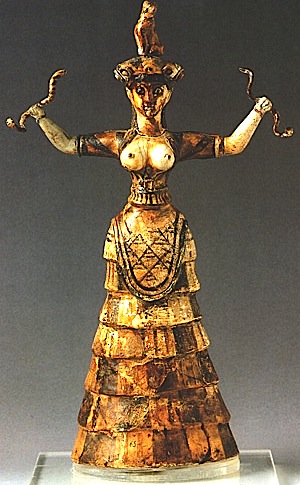Over 100 years after the excavations at Knossos, Crete, it is hard for the modern observer to appreciate the excitement engendered by Evans’s finds. Here was a whole new civilization with artistic achievements rivalling Egypt’s. Evans himself fostered expectation by dwelling on the modernity of the style and by embarking on a (now) controversial restoration programme which owed much to his own romanticized image of the ‘Minoan’ (his own word) past. As Minoan artefacts became prestige objects for museums, unscrupulous dealers, smugglers and restorers were quick to react. Top of the wish list was the snake goddess.

With her full exposed bosom, pinched waist, flounced skirt and modern expression, she looked exactly what was expected: an art even superior to that of Classical Greece and comparable to the Italian Renaissance. But Getty curator Kenneth Lapatin has suggested that the famous snake goddess might not be a genuine antiquity.
It is certainly true that from modest beginnings in Crete in 1903, the production of modern Minoica moved onto a world-wide market. In 1914 the Boston Museum of Fine Arts paid a staggering $950 for a very damaged chryselephantine snake goddess with no detailed provenance. It has affinities with the faïences from the Temple Repositories but also a number of crucial unexplained differences, not least that it is the only example in Minoan art in which ivory is used for a female figure. Questions about its authenticity remain unanswered. In the 1920s the curator at the Fitzwilliam Museum, Cambridge, wishing to enhance the status of her department, fell for a marble snake goddess, once again with no provenance except for a vague ‘east of Knossos’. £2750 were duly paid to a local intermediary who said he had it through a Paris dealer. Doubts raised in Crete were set aside and ascribed to jealousy and embarrassment at having allowed such a unique artefact to leave the island. Yet questions soon began to be asked. No archaeologist had actually seen the object come out of the ground. Authentication was based purely on style, subjective judgement and expectations. Evans was still defending it in 1935 but the Fitzwilliam Museum, after demoting its status to ‘dubious’ in 1964, last showed it in 1991.
Who dunnit? Evidence points in two directions: first the Gilliérons, father and son, who worked as restorers for Evans from the very beginning and eventually set up shop in Athens producing fine detailed replicas of Knossos finds for academic collections. Alternatively it was one of the Cretan workers trained by them. Sir Leonard Woolley in his memoirs tells how a forger, confessing on his deathbed, had wept bitter tears on discovering how much money his work could ultimately command.
Extract from Blue Guide Crete by Paola Pugsley. Knossos is also one of the sites featured in Sites of Antiquity: 50 Sites that Explain the Classical World.
For more on the Gilliérons and the artworks of Knossos, see here , for details of an exhibition currently running at the Met Museum in New York.







With the find of the Palaikastro Kouros: Minoan Chryselephantine Statuette in a carefully controlled dig, I think the charges of forgery need to be re-evaluated. The Boston Museum Snake Goddess reminds me of the Palaikastro Kouros.